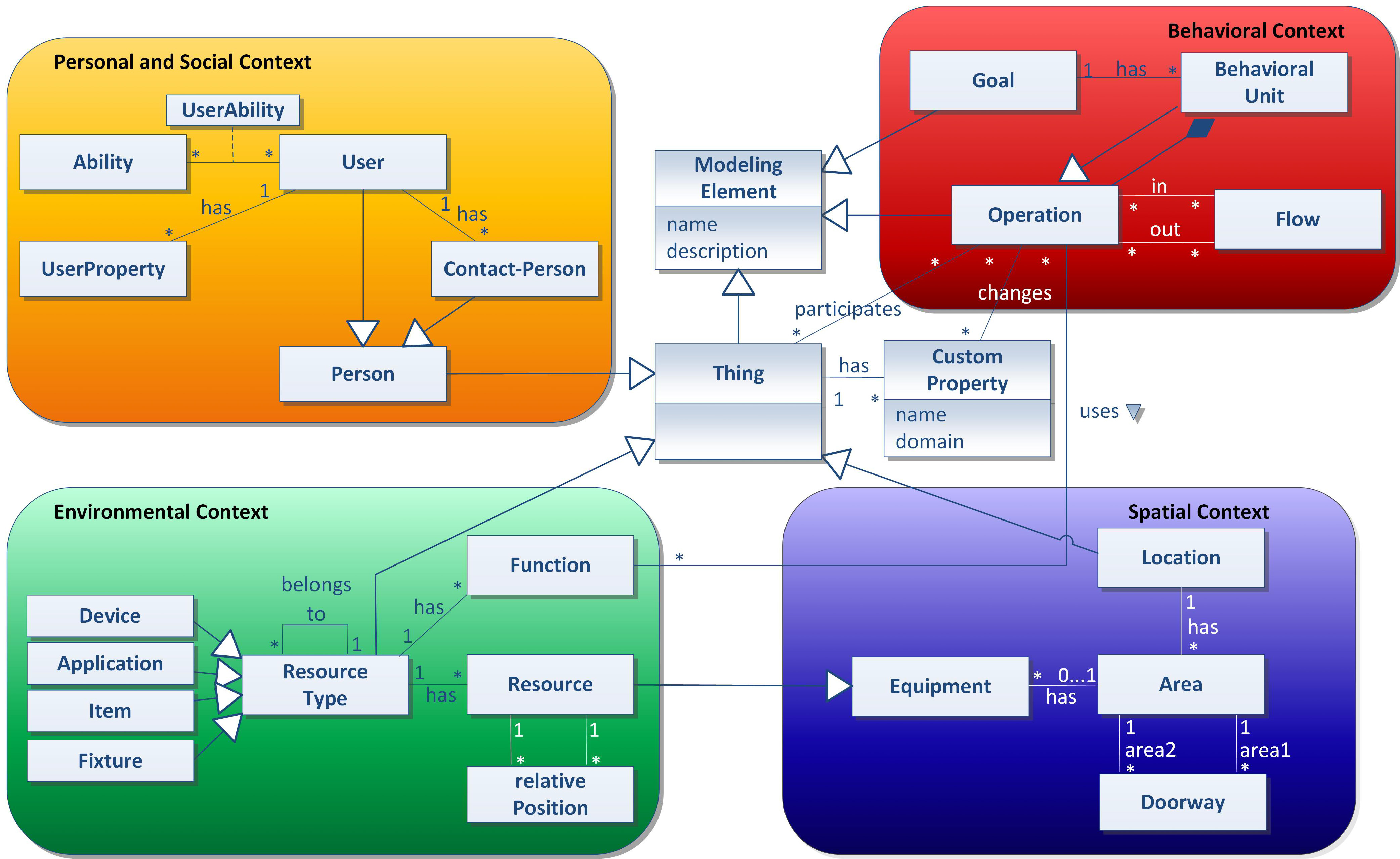HBMS: HCM-L
Human Cognitive Modeling Language
Human Cognitive Modeling Language
Conforming to the Model Centered Architecture (MCA) paradigm, the conceptual Human Cognitive Model (HCM) of a person to be supported is the core HBMS component. A Domain Specific Modeling Method (DSMM) was created [MM15], including a conceptual modeling language, the Human Cognitive Modeling Language (HCM-L) [MM13], and a related modeling tool [AMM14].
HCM-L models are used in HBMS twofold: as conceptual models for communication and validation purposes between users and system engineers as well as machine readable context representations [AMM14] allowing context retrieval, reasoning, interoperability and reuse. The language was designed to be as intuitively understood as possible by the relevant stakeholders in the active assistance domain [MM17].
The associated HCM-L modeling tool has been developed using the meta-modeling platform ADOxx. Based on the HCM, behavioral active assistance is provided to a user by the HBMS-System.
HCM-L [Ma16] is used to describe behavior, personal and social, spatial and environmental aspects of a user’s behavior and it’s context at MOF level M1. The power of HCM-L in describing level M1 models is determined by its meta-model, which is positioned at level M2. Thus, the HCM-L meta-model is a model of M1 models and specifies possible context abstractions in HBMS using HCM-L. Finally, M0 includes instances from the real world active assistance, like behavior instances, actual context states or context history data.


As support will be individually given for each person based on her/his HCM, there is an individual HCM for each person.
Activities are in focus of support [MM15]. These are captured in HCM-L by the concept of Behavioral Unit (BU). Consequently, the HCM of a person consists of a set of BU’s together with related context.
A BU describes all possible sequences of actions that lead toward the particular activity’s goal. For modeling actions and their sequence, HCM-L provides the concepts Operation and Flow. To express that Operations are ‘part of’ a BU, they are graphically drawn inside a BU.
An operation without outgoing flow means that the BU’s ‘Goal’ is reached. Alternative actions or possibilities for a free choice in ordering of several actions are expressed by Pre- and Post-Condition Expressions, i.e. they allow arbitrary granularity for the control flow.
HCM-L allows for hierarchical structures: an operation can be again a BU and thus modeled in more detail. Several sequential operations of a BU can be summarized in a ‘Makro’. It has no semantic meaning but can be used to simplify BUs.
Modeling structural, spatial, personal, social and temporal contexts additionally to behavioral information, increases the model entropy and therefore the amount of helpful support information. For that purpose, HCM-L offers the concepts for modeling the personal and social context (for example abilities of the user), the environmental context (e.g., functions of different resources, different variants of resource types) and the spatio-temporal context (e.g., equipment in different areas, time dependent phenomena) [MS17].
References
[AMM14] Al Machot, F.; Mayr, H.C.; Michael, J.: Behavior Modeling and Reasoning for Ambient Support: HCM-L Modeler. In: Modern Advances in Applied Intelligence; Proc. 27th Int. Conf. on Industrial, Engineering and Other Applications of Applied Intelligent Systems. Springer LNAI Vol. 8482, 2014, pp. 388-397. DOI: 10.1007/978-3-319-07467-2_41
[Ma16] Mayr, H.C.; Al Machot, F.; Michael, J.; Morak, G.; Ranasinghe, S.; Shekhovtsov, V.A.; Steinberger, C.: HCM-L: Domain Specific Modeling for Active and Assisted Living. In: Domain-Specific Conceptual Modeling – Concepts, Methods and Tools. Springer, 2016, pp.527-552. DOI: 10.1007/978-3-319-39417-6_24
[MM13] Michael, J.; Mayr, H.C.: Conceptual Modeling for Ambient Assistance. In: Proc. Int. Conf. on Conceptual Modeling, ER 2013, Springer LNCS 8217, 2013, pp 403-413. DOI: 10.1007/978-3-642-41924-9_33
[MM15] Michael, J.; Mayr, H.C.: Creating a Domain Specific Modelling Method for Ambient Assistance. In: Proc. Int. Conf. on Advances in ICT for Emerging Regions ICTer2015, Colombo, August 2015. DOI: 10.1109/ICTER.2015.7377676
[MM17] Michael, J.; Mayr, H.C.: Intuitive understanding of a modeling language. In: Proc. 13th Asia-Pacific Conference on Conceptual Modelling ACSW ’17, January 2017, Geelong, Australia; ACM, New York, NY, USA, DOI: 10.1145/3014812.3014849.
[MS17] Michael, J., Steinberger, C.: Context Modeling for Active Assistance. In: Proc. ER Forum 2017, CEUR-WS.org, Vol.1979, p.22
Nächste interaktive ULG-Vorstellung:
tba
Nehmen Sie an unsrem Meeting per Computer oder Smartphone teil.
https://global.gotomeeting.com/join/223661045
Zum ersten Mal bei GoToMeeting?
Hier können Sie eine Systemprüfung durchführen:
https://link.gotomeeting.com/system-check
![]()

